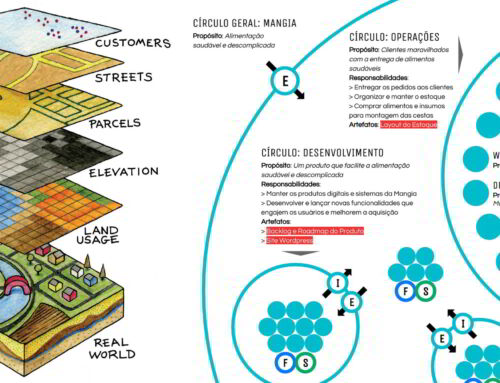A new organizational model is emerging: the so-called “Evolutionary Teal”. Three characteristics make it unique, completely different from what we know as “a company”. Understand what they are.
Self management
In traditional organizations, management is the responsibility of the manager or the “boss.” The work of planning, controlling, and coordinating is centered on this figure, while others follow what has been defined. Evolutionary organizations present a breakthrough with this practice: management becomes the responsibility of all. The boss’s coordination and control functions are replaced by highly transparent processes where peers are accountable to each other, creating a peer-presure environment.
In Holacracy all members of a circle participate in a weekly tactical meeting where they share their metrics and checklists. Everyone responds “check” or “no check” to the recurring activities of their roles. The checklist is defined by the circle people themselves. This mechanism guarantees the execution of the important activities, without the need of a centralized power. People who participated in both models (boss and peer pressure) say the second one is usually “stiffer”. You can fool your boss, but it’s much harder to fool all your colleagues.
Self-management systems do not use hierarchy or consensus, as in previous organizational models. Most decisions are made in an “autocratic” way, where the individual seeks the advice of peers for a decision, but not the “consensus” of all. For more important decisions, evolutionary organizations usually practice consent, which seeks to use the wisdom of the group to identify “objections” (some evil that the decision may cause) and integrate them into the initial proposal.
Consensus: Everyone believes that this is the best decision
Consent: Everyone considers the decision “safe enough to try” and “good enough for now”
Evolutionary Purpose
Evolutionary organizations do not seek profit alone. It’s bigger. According to Brian Robertson, the purpose can be defined as the deepest creative potential that the organization can sustainably express in the world. It is present in the day to day and directs the organization through the objectives, the strategy and the decision making. The purpose is never left out.
Purpose is a strong intrinsic motivator that attracts people who are not there just for the money and are not going to look for shorter ways that will harm the organization to climb the ranks, earn a bonus at the end of the month or satisfy the boss. Based on this premise, processes are radically simplified (in terms of control mechanisms) because it is an assumption that everyone is there to do their best and believe in the contribution of the organization
Evolutionary organizations are seen as a living organism with a sense of self-direction. People are more concerned with feeling, discovering and listening to purpose than about creating detailed plans to try to predict the future.
Wholeness
Do you wear a professional and uncomfortable dress when you go to work? If the answer is yes, you are probably not working in an organization with wholeness! Since the invention of hierarchy and processes, people have let go of the questionings, the uncertainties, the emotional and spiritual side as they go to work. There is a clear separation between the “personal self” and the “professional self”. We were taught to show determination and strength at work, leaving doubts and uncertainties at home.
In evolutionary organizations, everyone is invited to participate in an whole way. There is no separation between professional and personal persons. The purpose allows for the union of what I want, what I do and what I believe: I do not live to make money and then spend all of it at Disney.
I had the opportunity to work in an organization where I could bring all of my self. I argued with my colleagues about how I was feeling, about my insecurities and fears. And I did it without fear of being penalized. I once cried. I cried because it was difficult. Of course I was embarrassed, but I was not rejected. I was welcomed and encouraged to try again.
– A lucky guy
Self-management, evolutionary purpose, and wholeness make teal organizations a totally different environment from the corporatist world we know. Do you recognize these elements in your organization? Tell us more about them :)






[…] we have described in the 3 breakthroughs of organizations of the future, there is a new movement called evolutionary (or responsive) organizations that places purpose at […]
[…] we have described in the 3 breakthroughs of organizations of the future, there is a new movement called evolutionary (or responsive) organizations that places purpose at […]
[…] we have described in the 3 breakthroughs of organizations of the future, there is a new movement called evolutionary (or responsive) organizations that places purpose at […]
[…] we have described in the 3 breakthroughs of organizations of the future, there is a new movement called evolutionary organizations that places purpose at the heart of the […]